Many are wondering if it is possible to build in winter. You can, and both brick and frame houses. The main thing is to comply with construction technologies at low temperatures that we will tell.
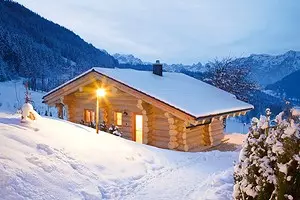
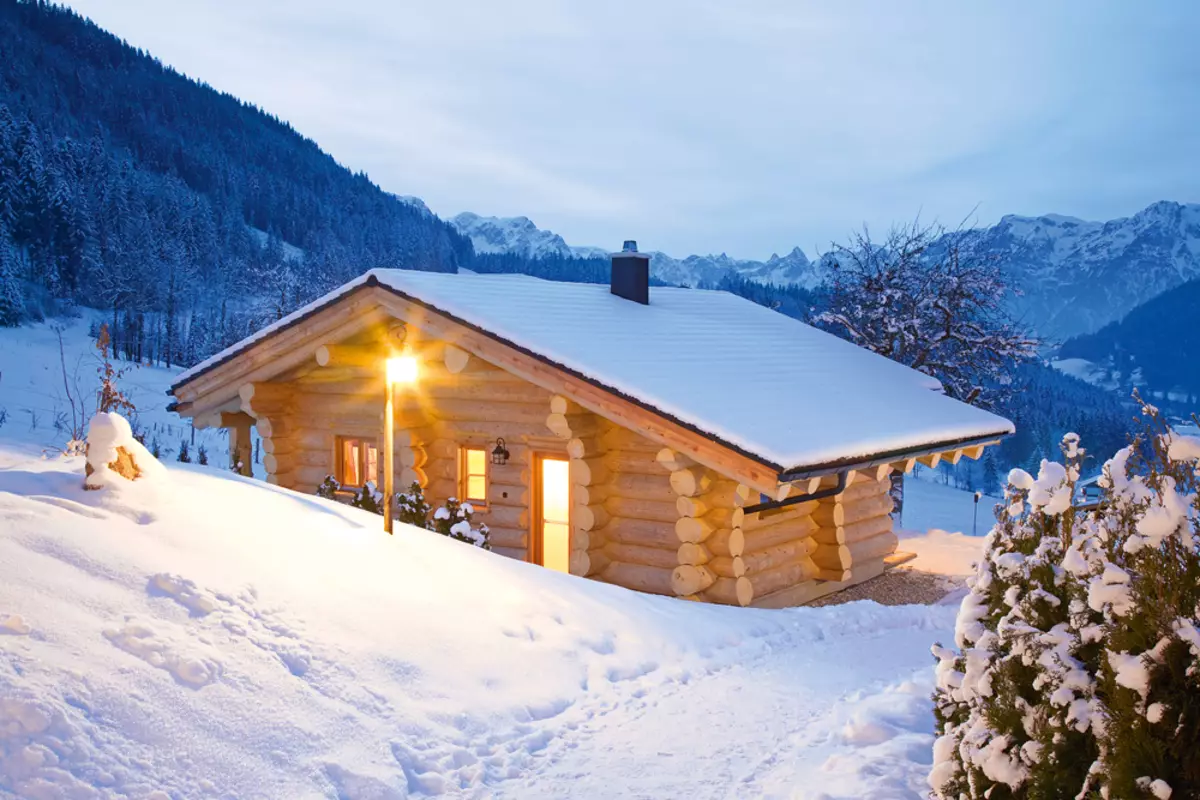
Photo: Andrei Shevchenko, Construction Company "Garant-Stroy"
Is it possible to build during the cold season? The opinions of specialists are reduced to the following: it is possible, but only if strictly observe the special winter rules for conducting technological processes. In Sweden and Finland, which are climatically similar to many regions of Russia, the "unresonal" low-rise construction has long become the norm. Build wooden (including frame) walls, overlaps and rafter structures, as well as mounted mounted facades Moderate frost does not interfere. At minus temperatures it is difficult to work with concrete, it is extremely undesirable to maintain facial brickwork and mount a flexible tile, it is impossible to plaster and finish the facades with a stone or tile.
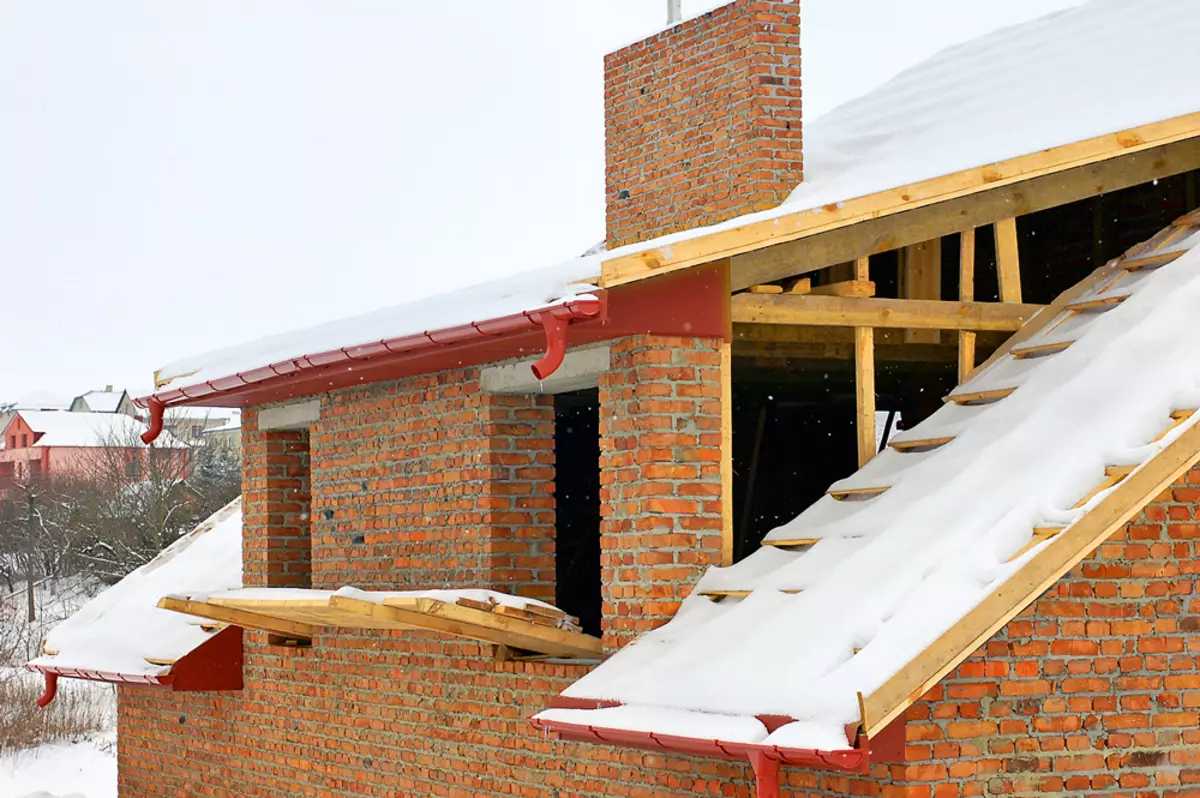
If it is decided to stop work for the winter, then the construction site must be presserved: closure and mounted temporary roof. Photo: shutterstock / fotodom.ru
How to pour the foundation in the frost
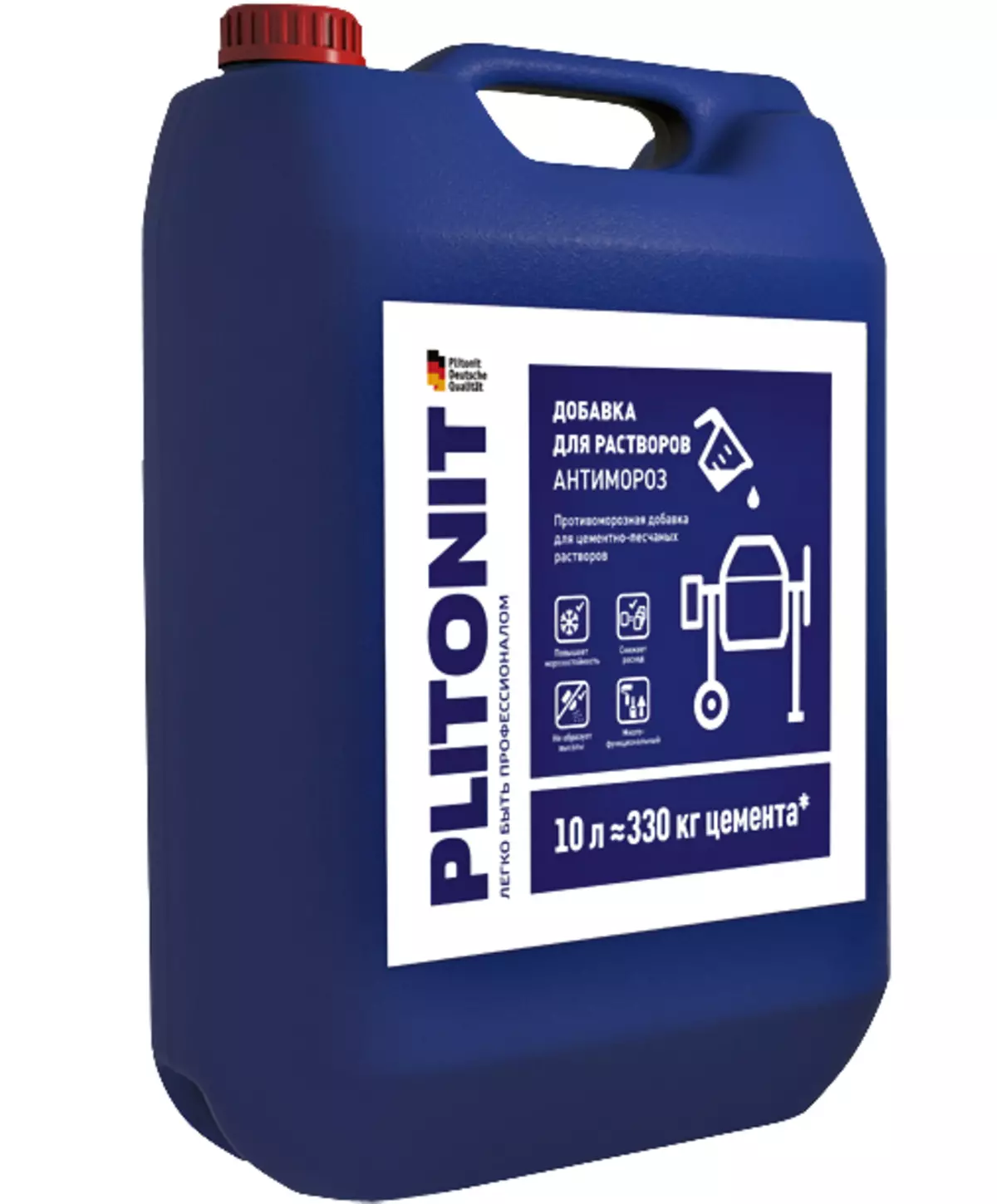
Anti-frosty additives are added to the concrete, as well as plasticizers to increase the flow of material and substances, accelerating a set of strength. Photo: Plitonit.
The basis of the house is the foundation, which is most often made of concrete. At temperatures below 5 ° C, you have to look for special approaches to concrete. One of them is the use of a heated solution. In the process of its preparation, water, sand and crushed stone are heated. In this case, the temperature of the concrete should not exceed 40 ° C and be below 20 ° C, otherwise its mobility will be significantly reduced. The task of the manufacturer - to make a warm composition as quickly as possible to the construction site. The cost of such a concrete is at least 30% higher compared to summer. To ensure optimal condition for a set of strength, concrete is poured into a preheated base and insulate the formwork.
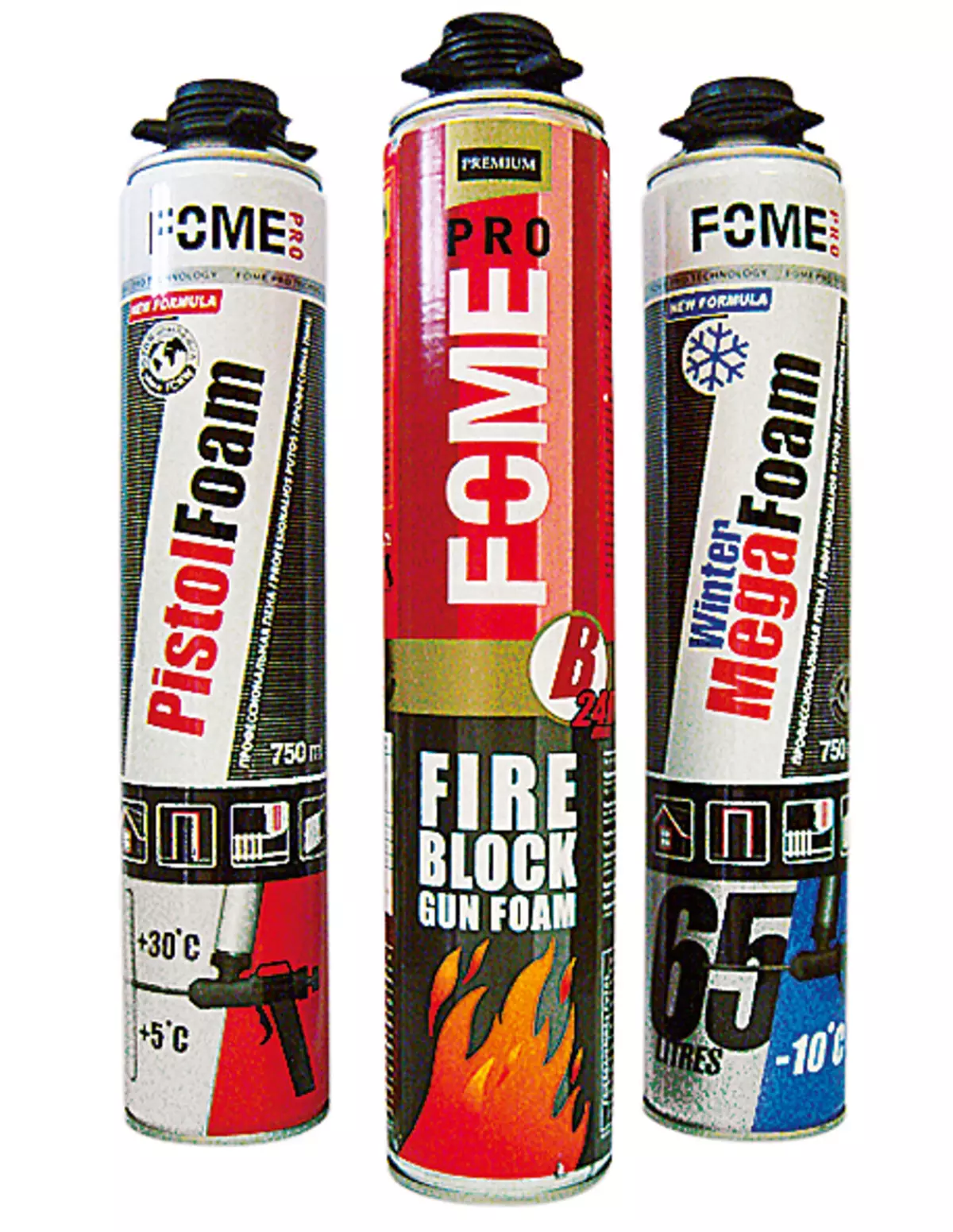
When mounting windows and doors and laying pipes, do not do without polyurethane foam, the main characteristics of which are frost-bone, output and density. Photo: "Systems-pro"
Another option is to use a cold concrete in which frost-resistant additives (additives) are introduced, lowering water freezing and accelerating the cement strength. Most often, substances based on sodium nitrite, carbon dioxide, sodium chloride are used as such additives. It is important to strictly observe the proportions of the mass of concrete and the frost-resistant additive. If the substances are not enough, the concrete will begin to freeze and the process of formation of the cement stone will cease.
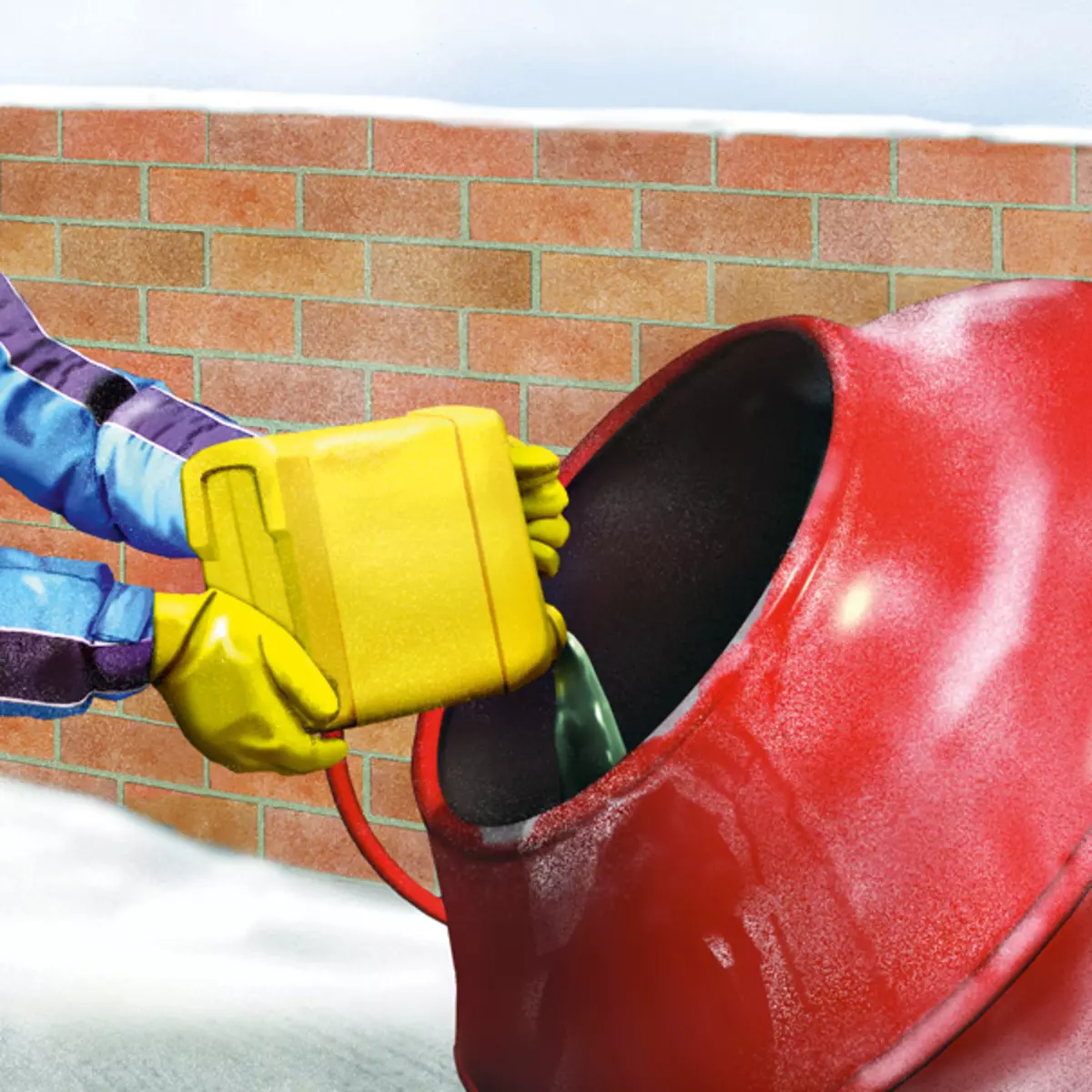
Compact concrete mixer ensures a uniform distribution of antiorrosal additives throughout the volume of the mixture. Photo: Sika.
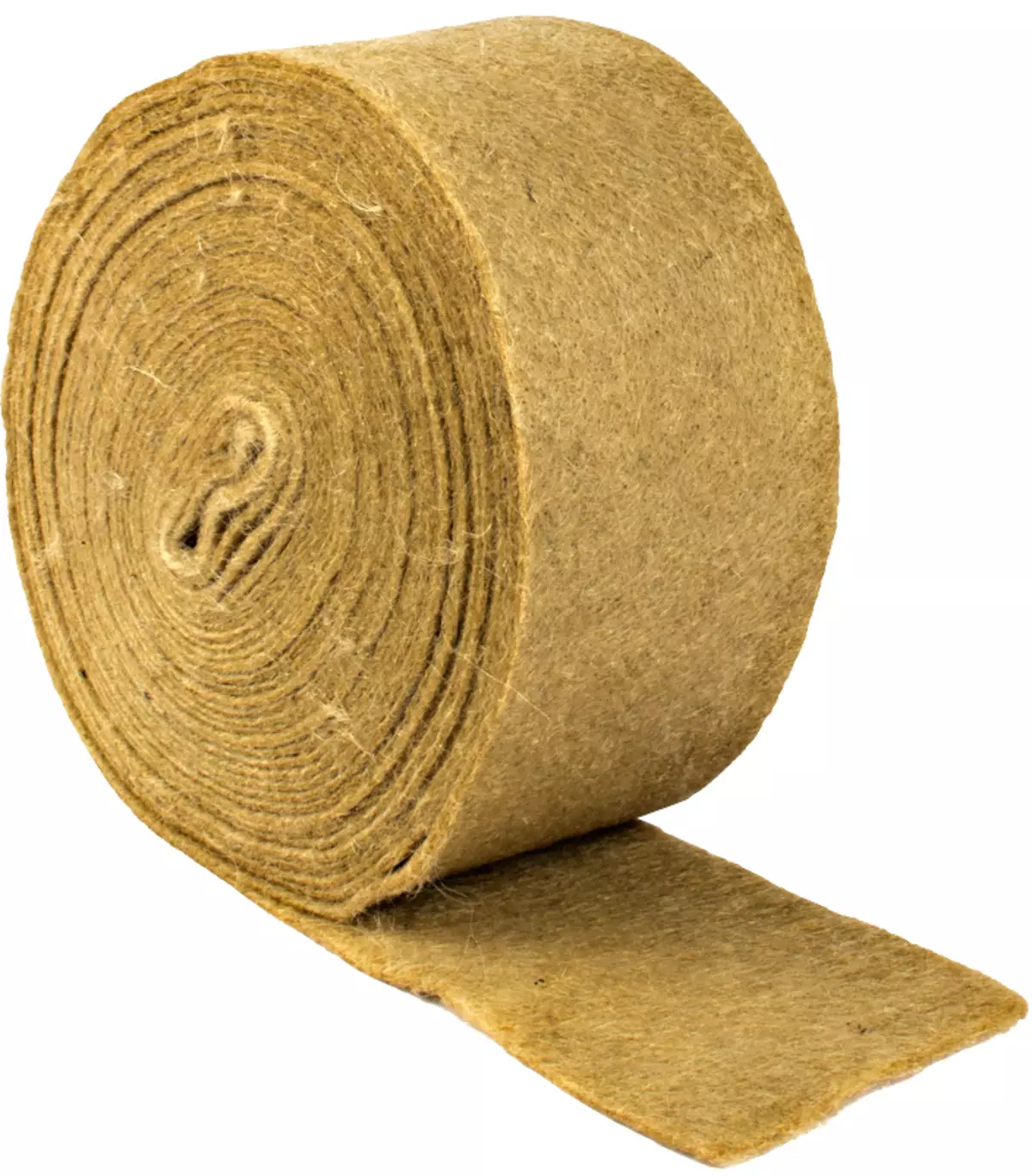
Winter is quite the right time for the cutting of a church, which has given the main shrinkage. For punching interventical seams it is convenient to use the jute tape. Photo: "Lona Group"
The use of frost-resistant additives allows operating at air temperature to -25 ° C, however, the technical properties of the modified cold concrete is worse than its traditional counterpart. Therefore, there are a number of restrictions on the use of this material. Thus, concrete with antiorrosal additives can not be used in pre-stressed structures, as well as in structures subject to dynamic loads. If sodium chloride or calcium chloride acts as additives, then such concrete can not monolite the joints of the precast concrete structures, which have revenues of reinforcement or steel mortgage parts without special protection, and use them to build elements of the building, on the surface of which are not allowed.
Concrete mixture with antiorrosal additives can be ordered at the factory (the average cost together with delivery within 40-50 km from the plant - from 5500 rubles. Per 1 m3), and you can make it yourself, if, for example, it is required relatively little or permissible phased Filling the foundation. All supplements are sold in packages with instructions, compliance with which serves as a key to creating a solid monolithic structure. How to work with the "cold" concrete? The mass is placed in the formwork and compact. The temperature of the mixture after the seal should exceed the freezing temperature of the aqueous solutions of antiorrosic additives at least 5 ° C. The surface of concrete, not protected by formwork, is covered to avoid moisture freezing. Concrete is kept under the shelter until the reachable strength is reached.
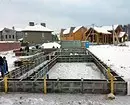
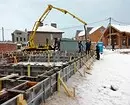
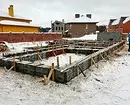
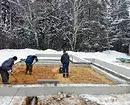
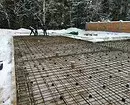
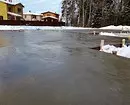
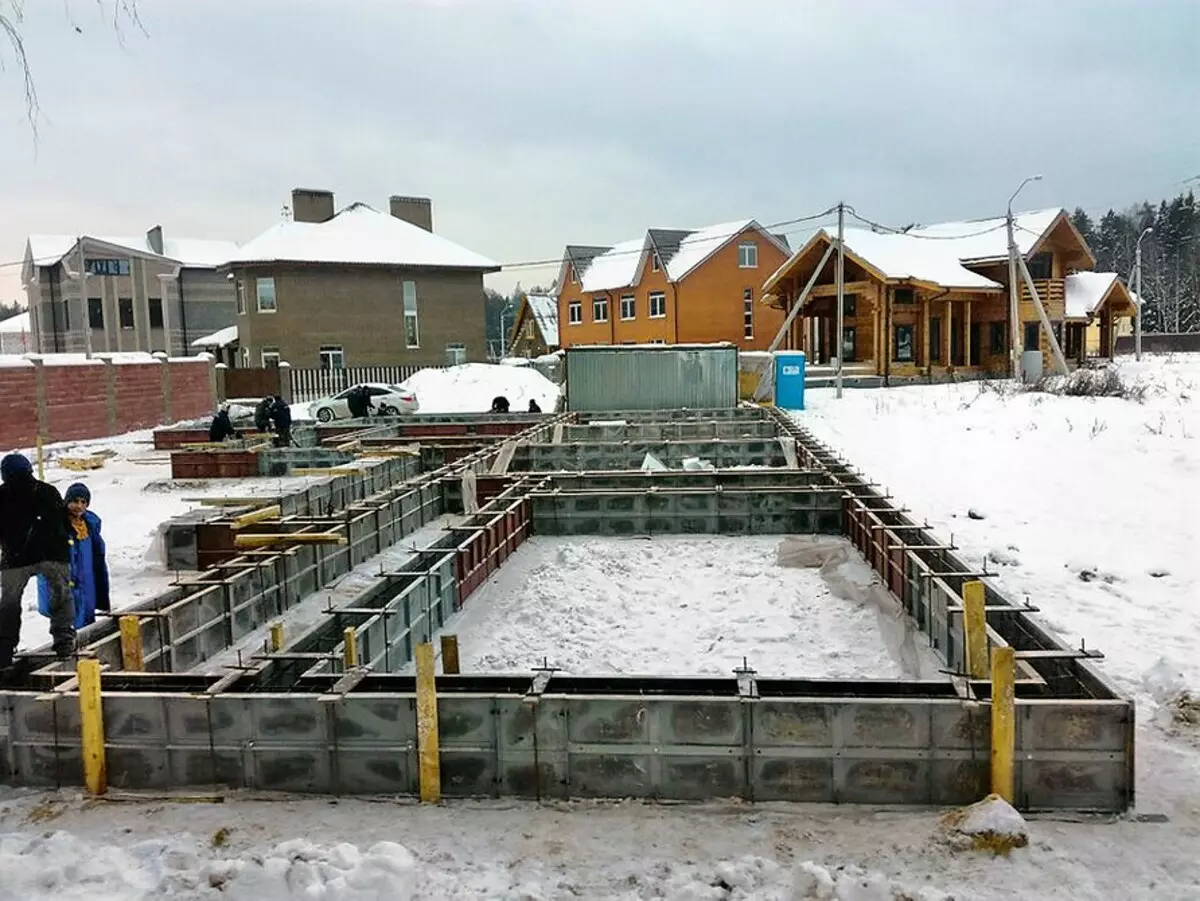
Small formwork is easy to assemble, but does not protect the concrete from the cold. Photo: Izba de luxe
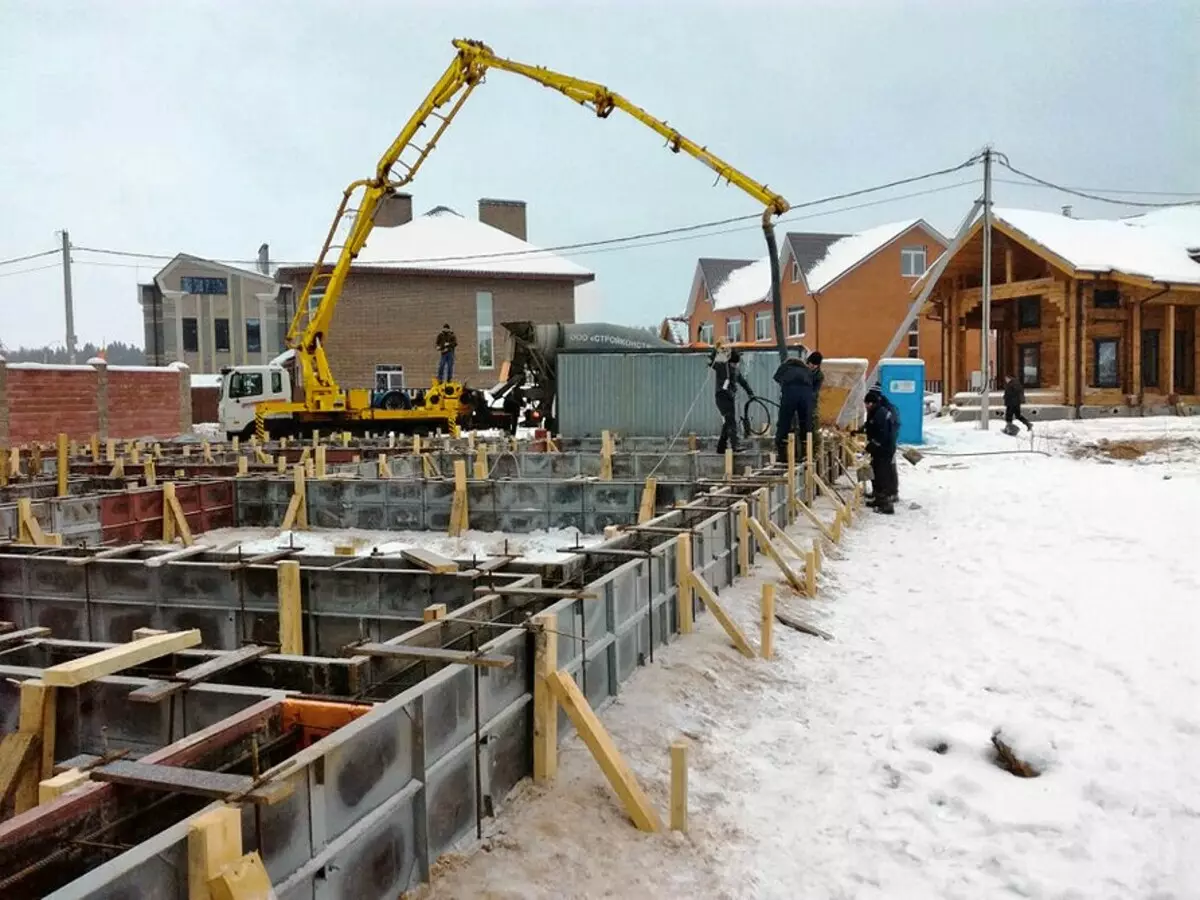
Therefore, use the winter mixture, which is supplied with a mixer pump
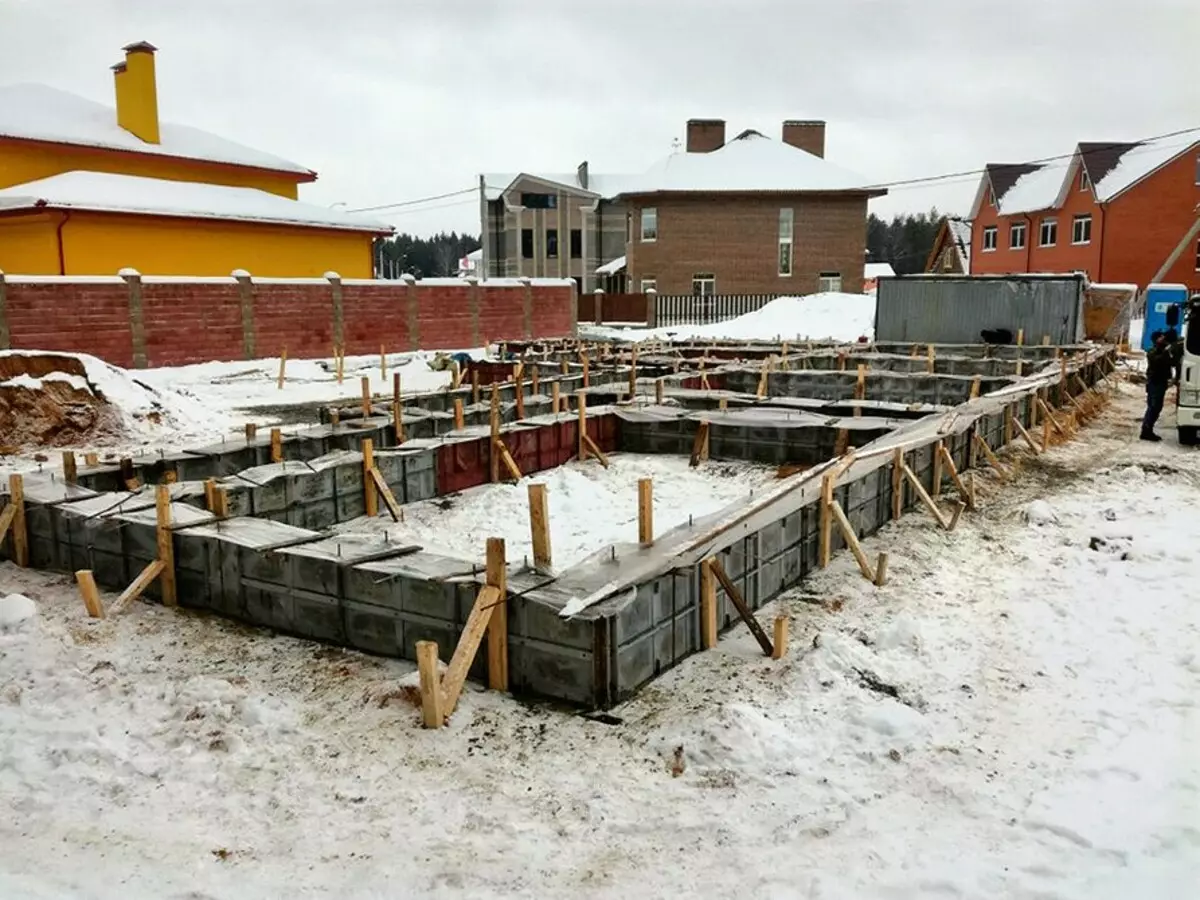
Next, the foundation ribbon is closed with a thick PVC film to prevent falling and slowing down the heat loss concrete
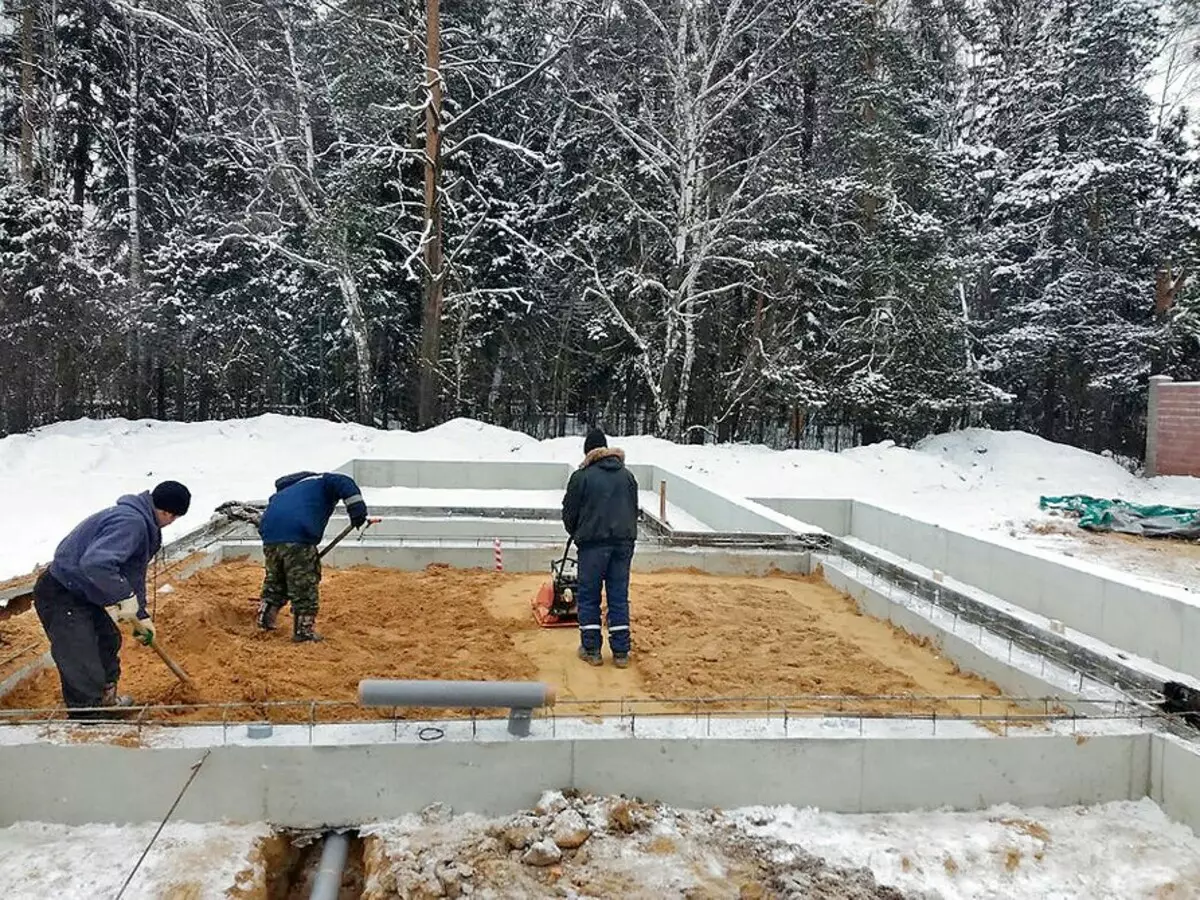
At border temperatures (from +3 ° C to -3 ° C), you can fill the base slab. At the same time poured and trambed a sand pillow
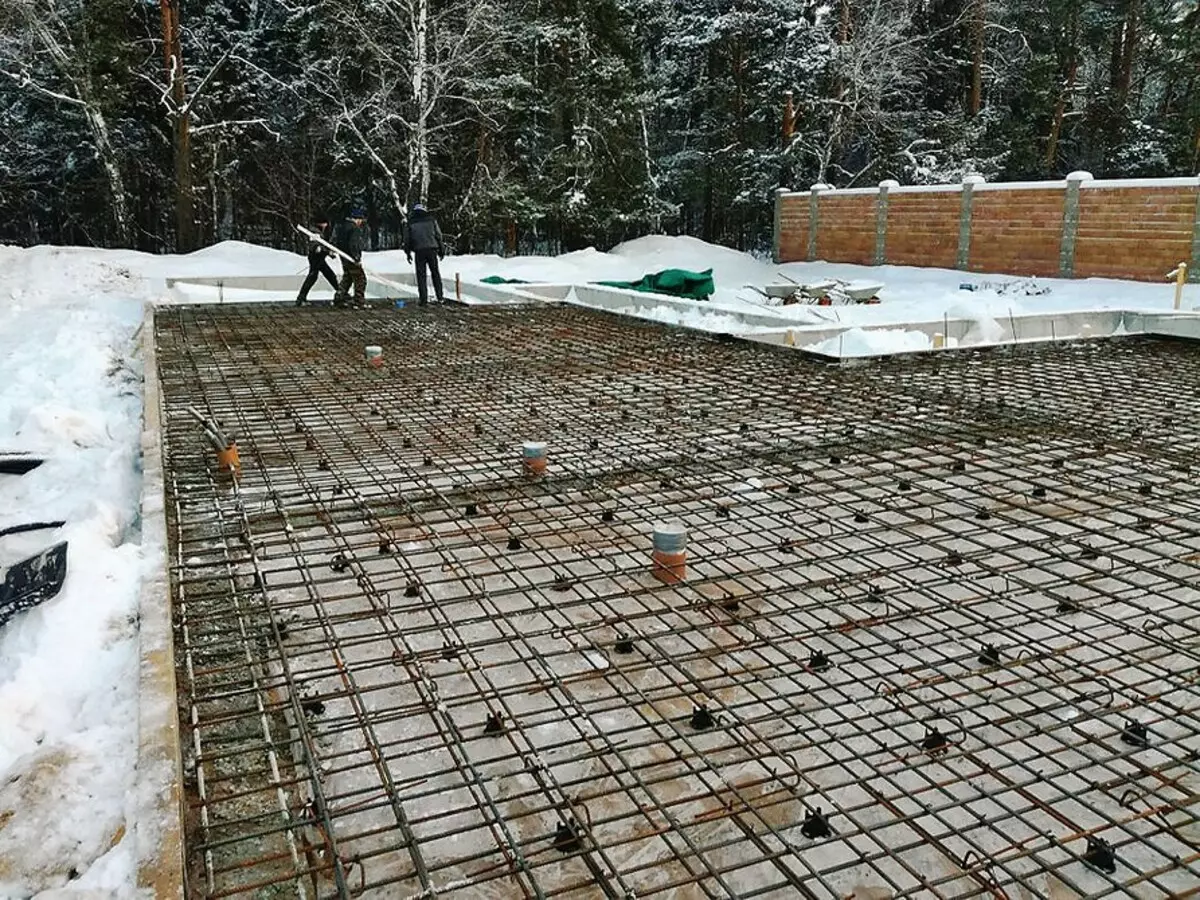
Mount two-level reinforcement frame
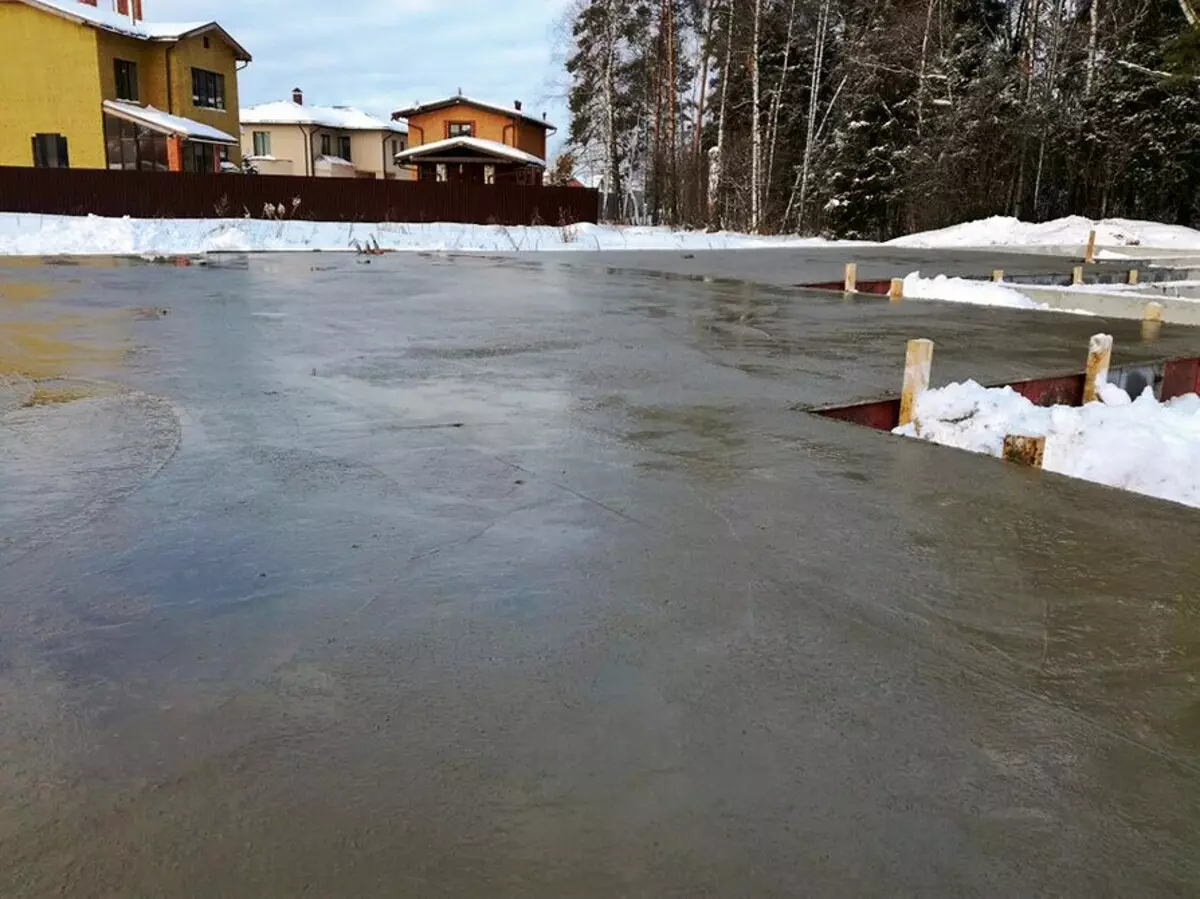
Placed concrete with anti-frosty additives
Nevertheless, the foundation of the foundation in the winter is the process of troublesome and time consuming. The cost of growing trenches or pitting is far growing, because even for an excavator, a thick layer of the murred soil can create a serious problem. Distribute trenches manually all the more difficult: the earth will need to drop scrap. It is useless to warm her bonfires, and the device of a heated tent from the film will be very expensive.
Such methods of winter concreting, such as the electric heating of the mixture and the installation of thermosetting formwork, are too expensive and do not justify themselves in private low-rise construction.
As an alternative to concrete, it is possible to recommend using a quick-scale pile-screw foundation with a scaperer paint. True, it will only fit for relatively light (frame, brusade) buildings with a calculated service life of no more than 60 years.
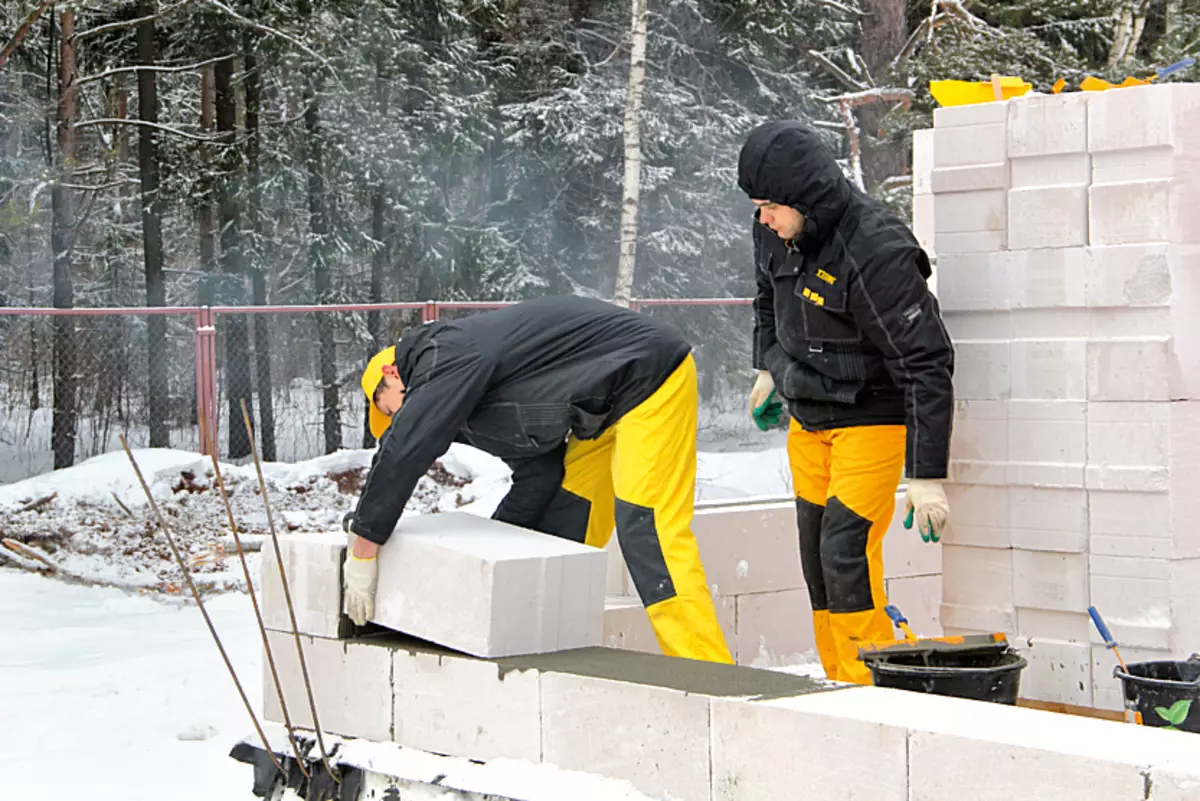
Build walls of materials such as foam block and a ceramzite-concrete block, you can. True, it is necessary to ensure that the harvested blocks and fragments of the masonry are covered and not formed on the surface of the material. In addition, the composition of the solution is very important. Preference should be given to special winter adhesives and modified cement mixtures. Photo: "Hebel-block"
On the properties of concrete
Concrete and masonry solution are the most vulnerable materials in winter construction. At a negative temperature, the water contained in their composition begins to freeze. In this case, the fluid increases in volume by 9%, and the pressure growing in the pore destroys the structure of a non-hardened mixture. Frost is dangerous precisely fresh concrete. After reaching 50% strength, the influence of low temperature is not so significant. It is also worth noting that the mass of concrete freezes slowly, besides the process of cement hydration - exothermic, so that the mixture hesitates itself.
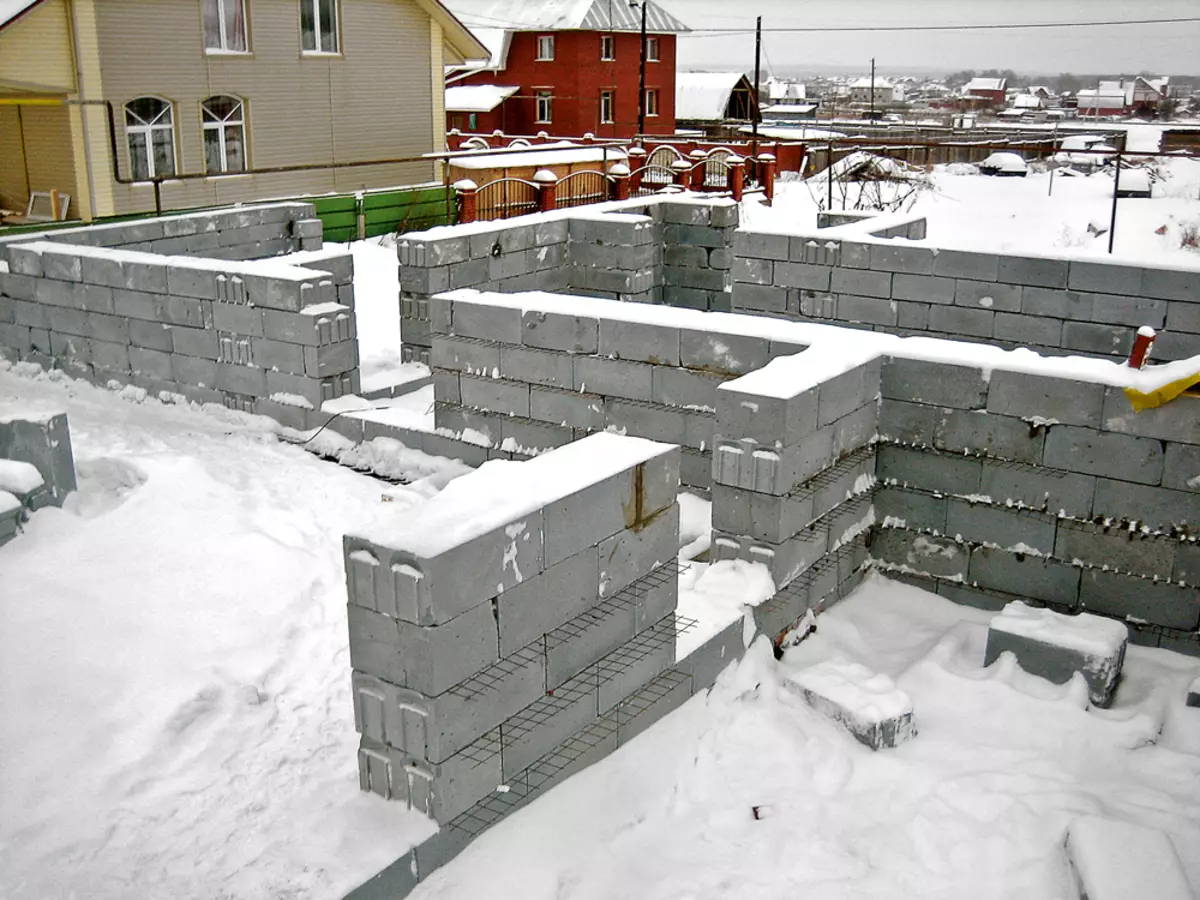
Ceramzite concrete block. Photo: "Cement Plus"
Features of brick masonry
There are two main methods of brickwork at low temperatures - "freezing" and the use of special additives. The essence of the first is as follows. An ordinary cement-sandy solution having a positive temperature at the time of work, soon freezes in the seams and hardens mostly in the spring after the masonry flaps, as well as during the winter and spring thaws. So that the temperature of the solution did not have time to fall below the calculated, the masonry lead accelerated pace. The prepared solution should be consumed for 20-30 minutes.
Most experts converge in the opinion that the laying of the freezing method is better not to lead. The fact is that with a quick freezing of fresh masonry in the seams, a mixture of binder and sand saccinated by ice is formed. The solution very soon loses the plasticity, horizontal seams remain not sufficiently compacted, and when thawing, they crimp the gravity of the overlying masonry, which can lead to a significant and uneven sediment and create a threat to the strength and stability of the structure.
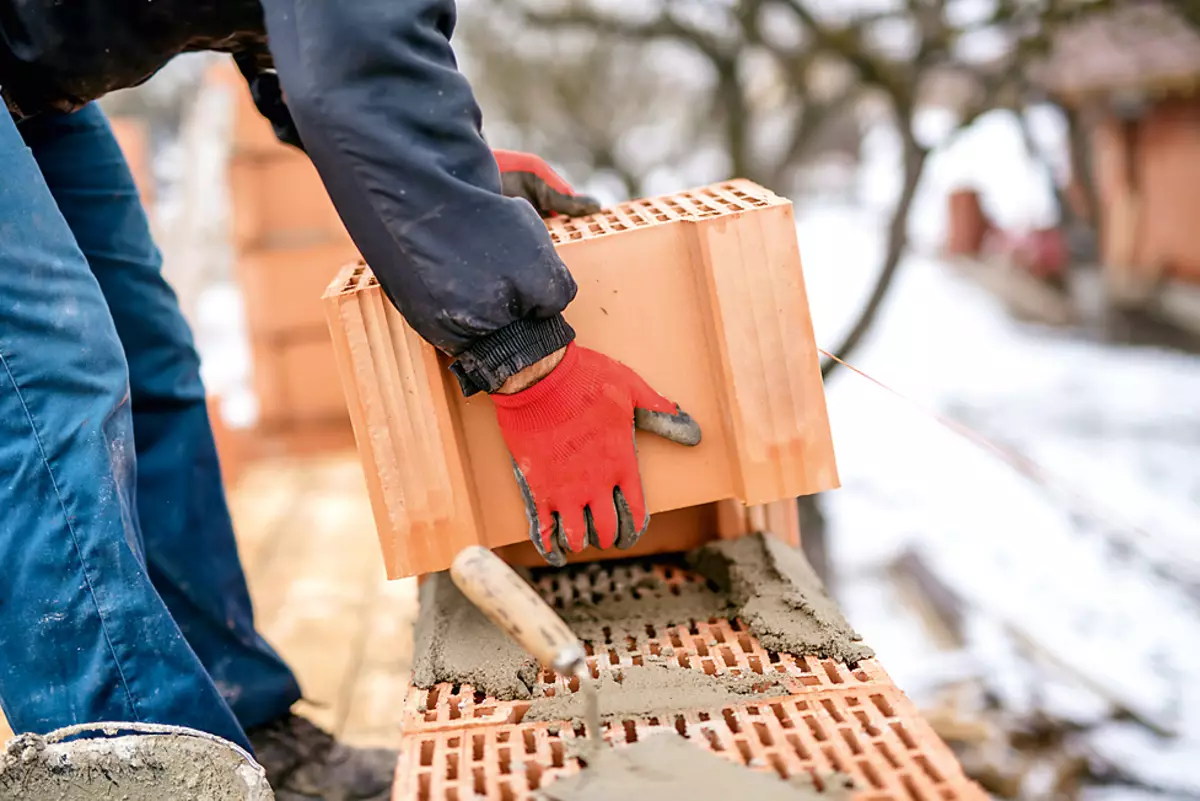
The picked ceramic unit can be laid on a heated solution at an air temperature not lower than -5 ° C. Photo: shutterstock / fotodom.ru
The second method involves the introduction into a solution of special additives, accelerating the chemical process of cement hardening. Thanks to them, it has time to gain strength at a negative temperature (up to -10 ° C). But restrictions, as in the case of the "cold" concrete, are also available. In particular, the use of a solution with antiorrosal additives can lead to the appearance of heighters on the front side of the masonry. Therefore, the use of such a mixture for a particular type of stone structures should be coordinated with the project organization.
Roofing Winter
The rafter system in the winter period can be erected from any materials. But wooden structures require special attention. Since at -20 ... -25 ° С The wood of natural humidity becomes fragile, the attachment of the rafter represents certain difficulties - the tree can give a crack. Therefore, it is better to carry out work on creating a rafter system at higher temperatures. As a roofing, you can use any materials except bituminous tiles.
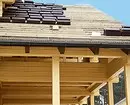
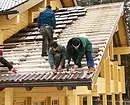
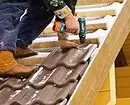
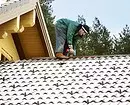
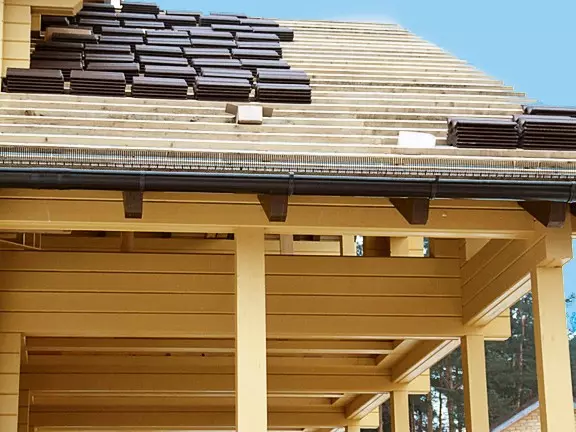
When installing the roof of the cement-sand tiles, the stacks of the material are evenly distributed on the plane of the skate, so that during operation do not move the products during operation. Photo: Tatyana Karakulova / Burda Media
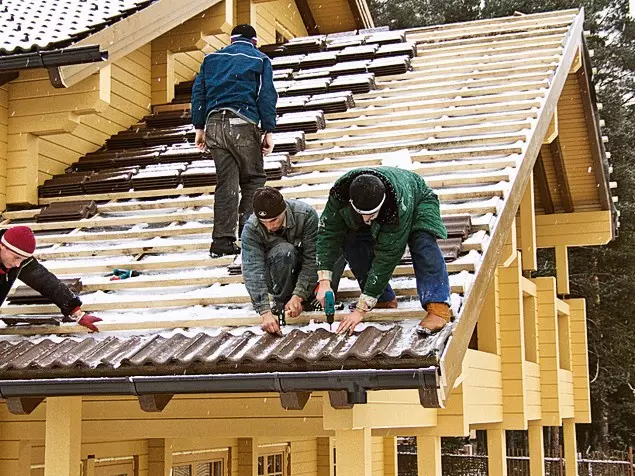
Stacking starts from the cornice tile, which is fixed with screws and anti-confer mesmers
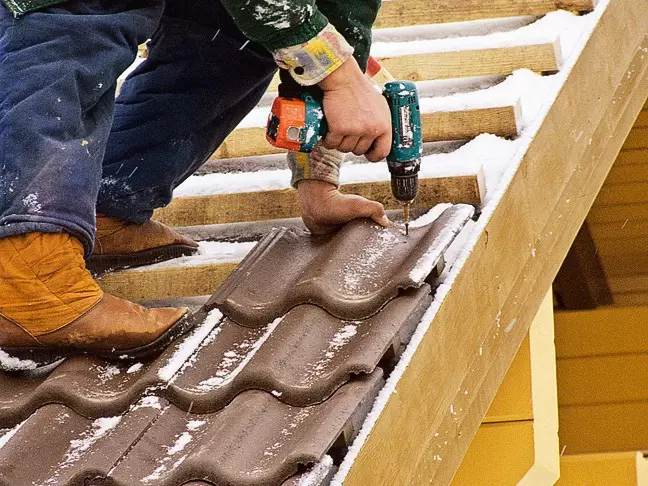
Side (frontal) tile columns are also subject to mandatory consolidation.
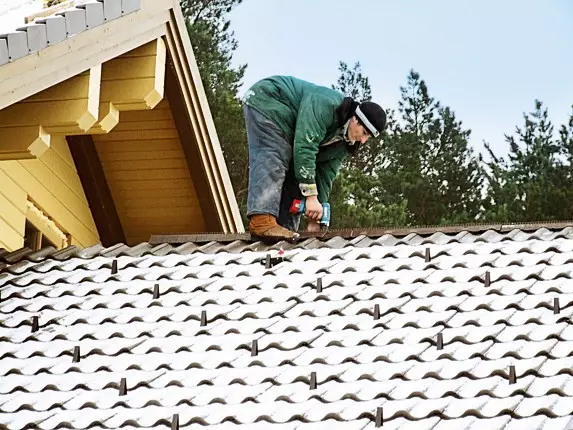
AFE plastic aeroe element, employee for roof ventilation
Winter mounting foam
There are winter, summer and all-season foam on the market. Winter foam can be attributed to an extraimatic, because it is permissible to use at temperatures from -10 ° C (in a number of manufacturers from -25 ° C) to -30 ° C. In winter, the humidity is low, and the composition needs moisture. Winter foam differs from summer what works in more complex conditions, even with insufficient humidity. It is necessary to pay attention to information as to which the temperature of the balloon should be, because most of the compositions before use must be heated. Some manufacturers assure that their foam can be used at -20 ° C, but the balloon should be warm. In this case, you will not have time to spend the entire balloon, as it will quickly cool. We must not forget that the Winter Pen is shelf life in short than summer.Construction of a wooden house in winter
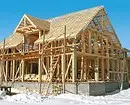
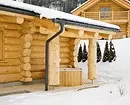
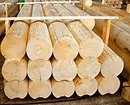
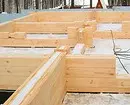
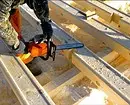
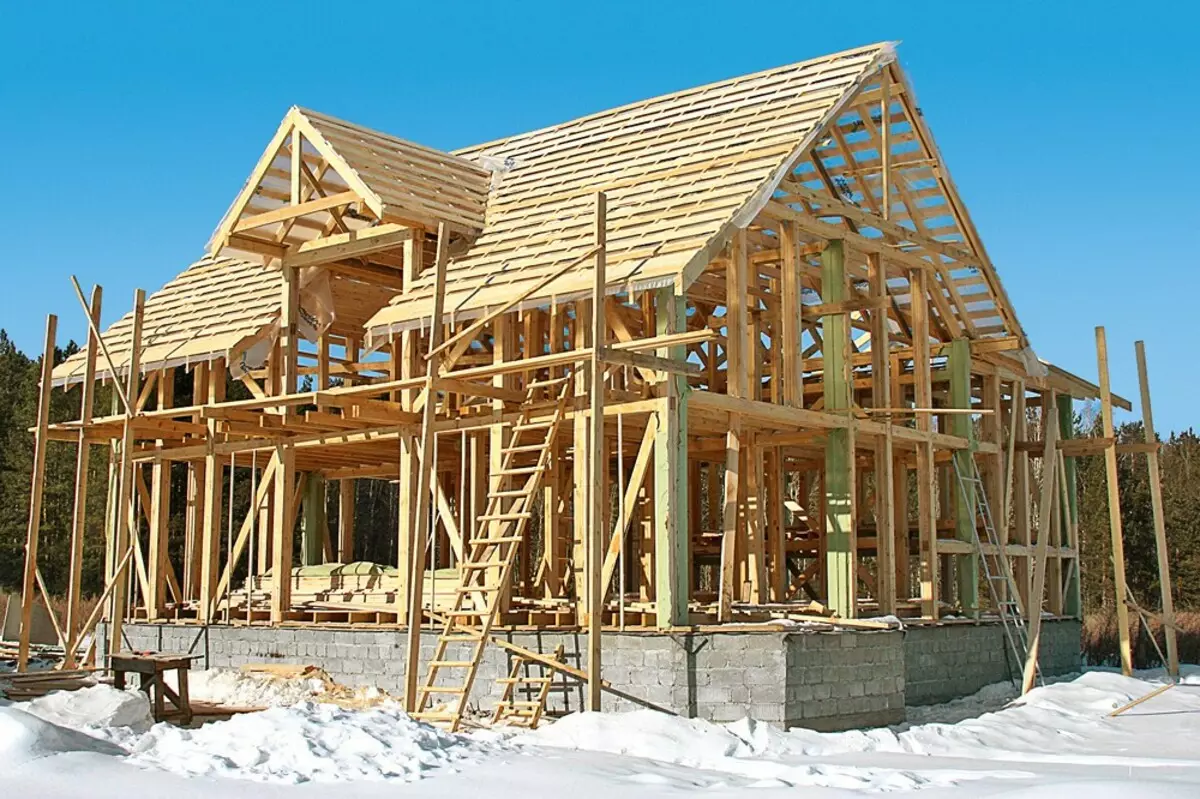
Frame details made of dry wood are afraid of rain and high humidity, not frost. Photo: "Cement Plus"
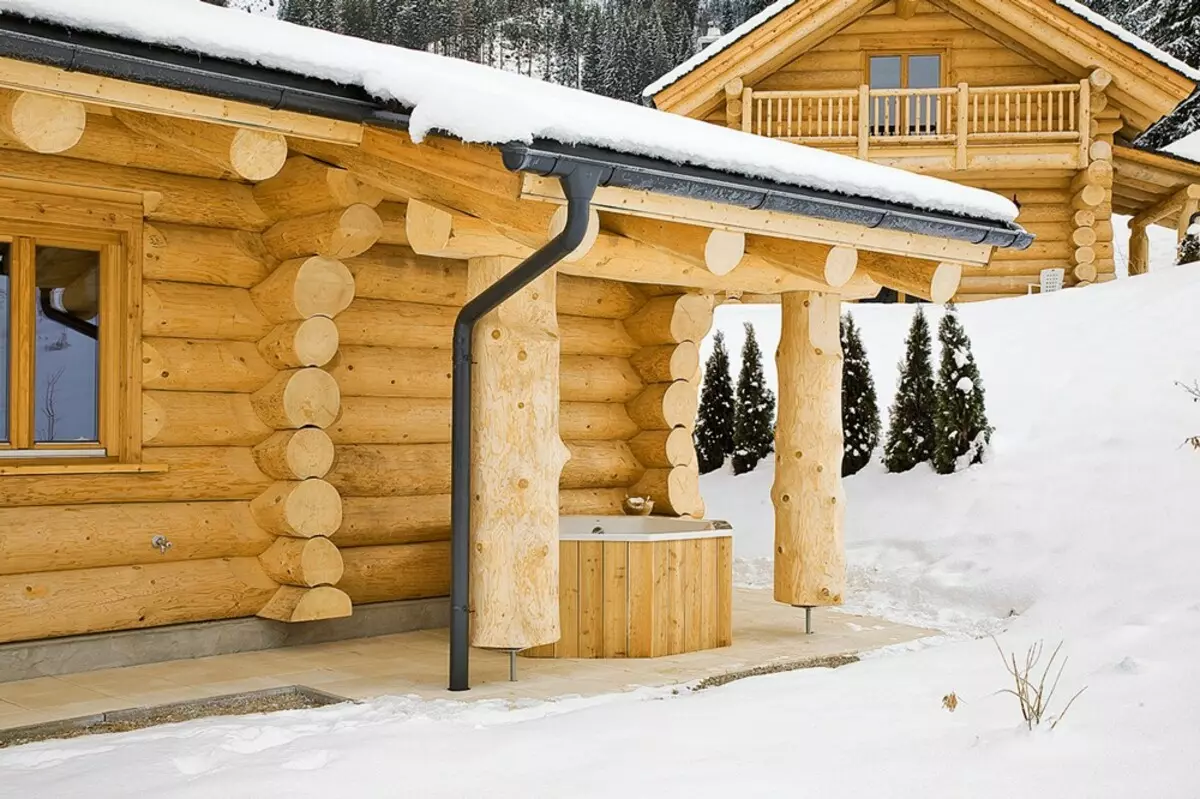
Control the shrinkage of the new log is necessary every 2-3 months, including in winter. At the same time, it is necessary to adjust the screw compensators and check whether it did not appear on the walls of the fungus, did not led the rafyled. Photo: Andrei Shevchenko, Construction Company "Garant-Stroy"
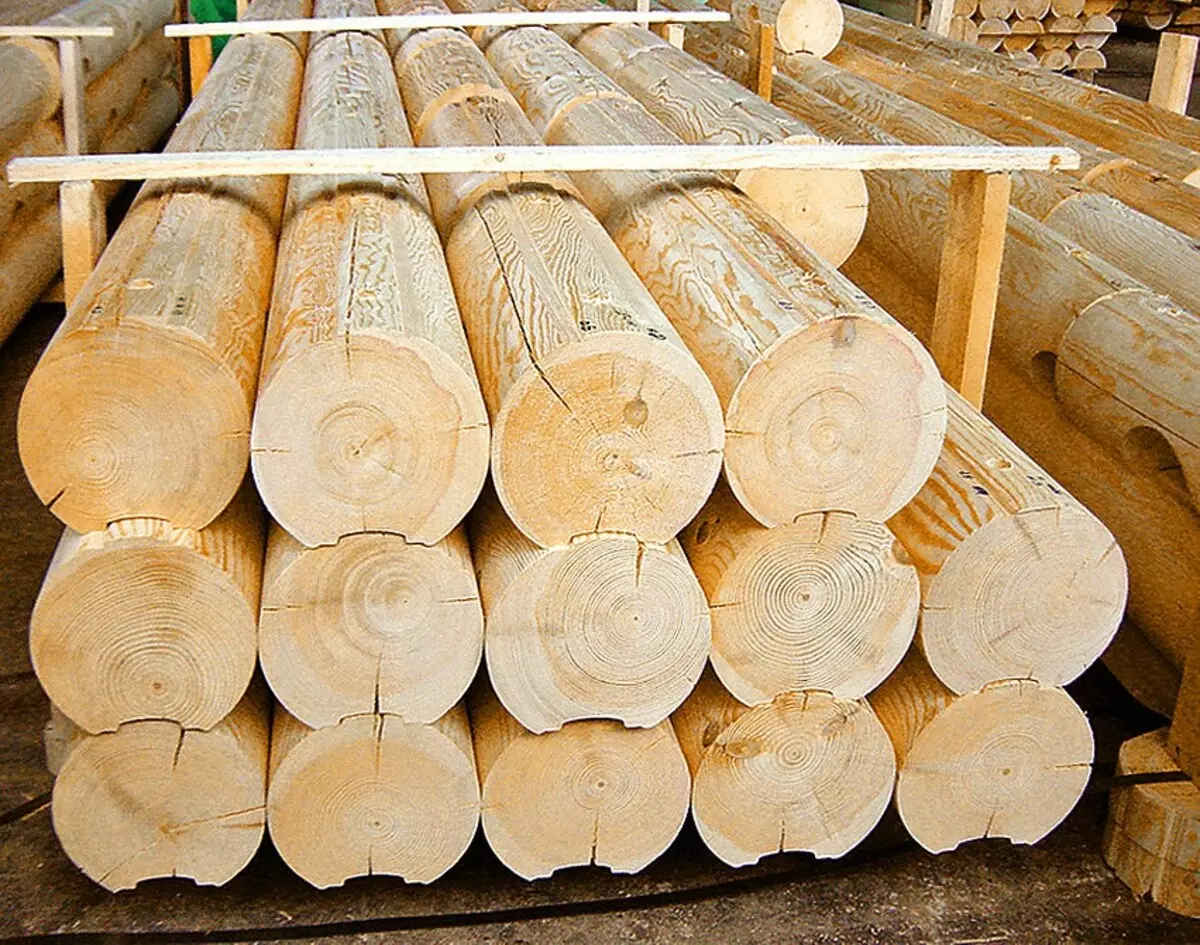
The house of the rounded log is made in the factory conditions (a), it is possible to build a box on the plot as in summer and in winter. Photo: Vadim Kovalev / Burda Media
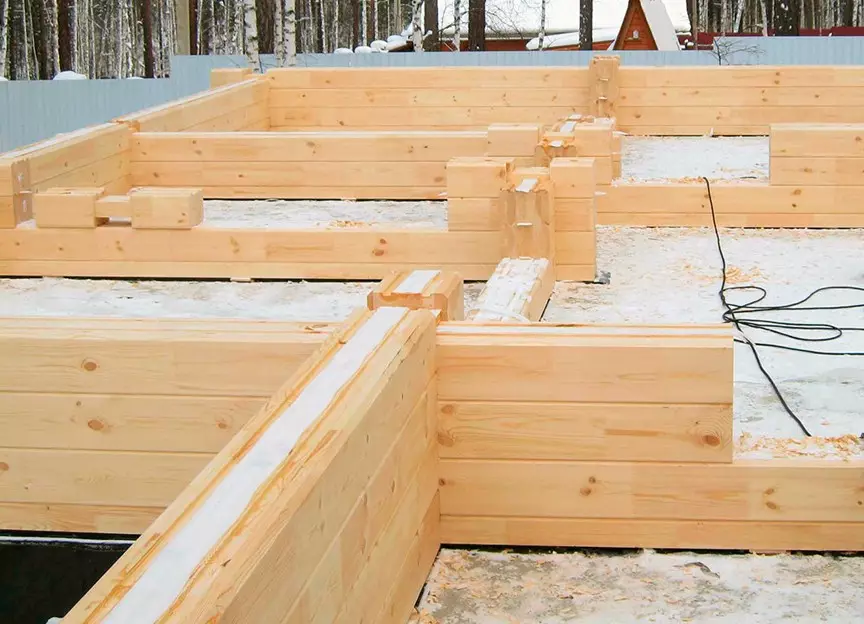
When assembling a log of a log or bar, it is necessary to ensure that it is not a wet of an interventic seal. Photo: "NB"
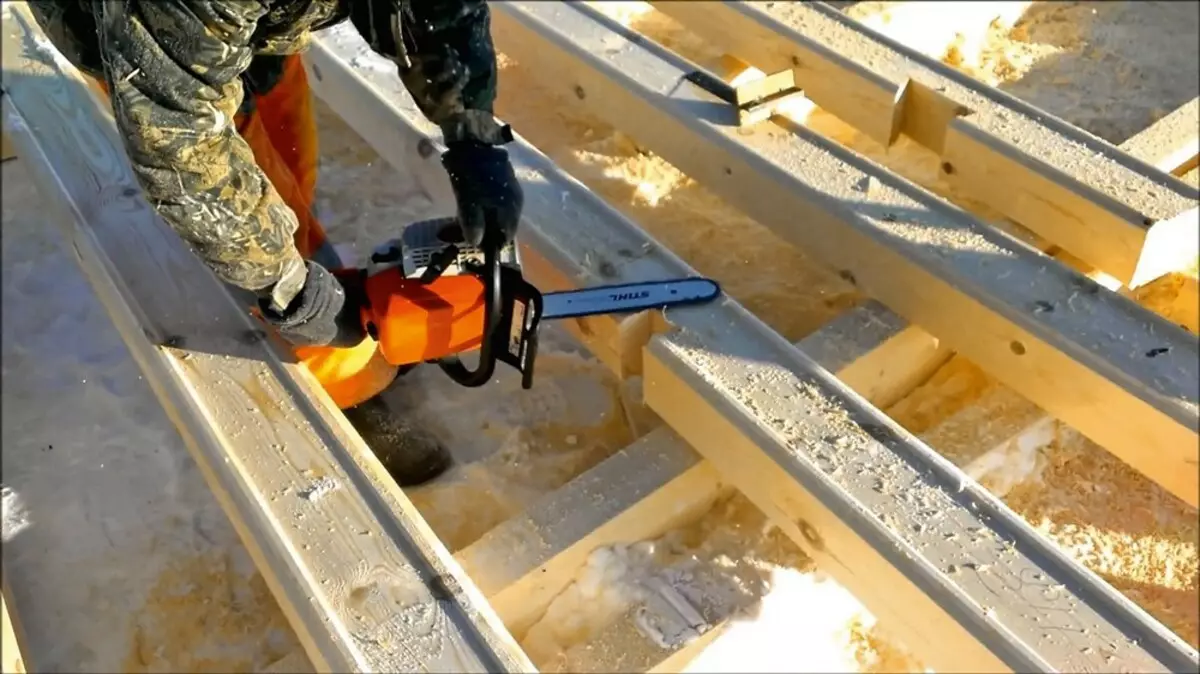
The bar, opened in the summer in the stack, contains relatively little moisture and does not freeze in winter, which allows you to cut it in size and choose the grooves and bowls on the construction site. Photo: Dombrus
The construction of wall structures from the gloves of seasonal or temperature restrictions does not have. Works are not conducted in the rain and snow to prevent the wetting of the interventional oxide compound and insulation. In winter, a short luminous day requires a device at the construction site of artificial lighting. Heavy, compared to the summer period, working conditions increase the time of work, and the complex road situation sometimes prevents the construction materials in the scheduled time. In general, winter construction is more expensive than summer, but the decline in prices for basic materials partially compensates for this difference. Of course, you can assign such works only by the company that has the appropriate practical experience.
Konstantin Maslov
Engineer of technical supervision GK "Izba de Lux"
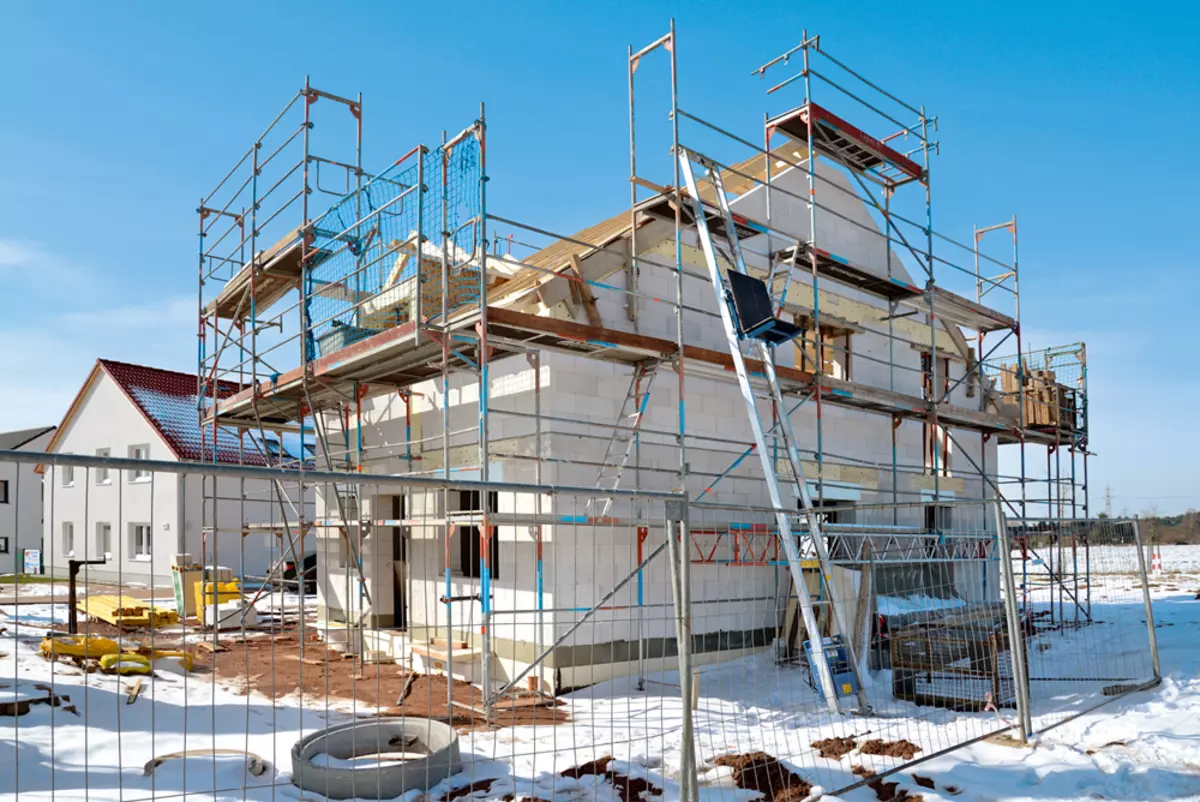
A frame building or a house from SIP panels will be erected on the plot for only 2-3 months, and the main building cycle can be planned during the cold season. Photo: shutterstock / fotodom.ru
The construction of a skeleton house in winter does not cause difficulties. We recommend using the foundation from the screw piles with the Russian team, with the device that large-scale earthworks is not required and there is no need to use heavy equipment. When the walls and roofs are insulated on the classic Canadian technology, it is necessary to take into account that the entire insulation "sandwich", as well as basic surfaces, should be dry (with high relative humidity, wet snow, the ice rain can not be carried out). Facade finish with lining and by any panels is allowed at low temperatures. Only plaster, plastering and painting works are excluded.
Sergey Saten.
Engineer of Sun-Stroy

